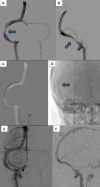Intracranial venous pressures and endovascular outcomes in pediatric patients with cerebral venous sinus stenosis
- PMID: 40924175
- PMCID: PMC12420681
- DOI: 10.1007/s00381-025-06938-7
Intracranial venous pressures and endovascular outcomes in pediatric patients with cerebral venous sinus stenosis
Abstract
Purpose: Diagnostic cerebral venograms are the gold standard for evaluating cerebral venous sinus stenosis (CVSS). Venous sinus stenting (VSS) and less commonly venous sinus angioplasty are emerging endovascular treatments in pediatric patients. This study examines the baseline intracranial venous pressures and postoperative endovascular outcomes in pediatric patients with CVSS.
Methods: A retrospective chart review was performed on patients ≤ 18 years old with CVSS between October 2021 and August 2024.
Results: A total of fifteen patients with CVSS underwent 20 endovascular procedures. The average age was 13.0 years of age (IQR 6-15 years of age) and 53.3% female. Eight patients (53%) were diagnosed with IIH by the revised Friedman criteria. Papilledema was present in 73.3% of patients with an average lumbar puncture or ventriculostomy opening pressure of 409 mmH2O. The average superior sagittal sinus (SSS) pressure was 24.3 mmHg (range 13-50 mmHg). The average trans-stenotic gradient was 8.5 mmHg (IQR 4.0-13.3; n = 14). Five patients underwent dural venous sinus stenting (mean pre-stent TSG of 17.0) with a significant reduction in the trans-stenotic gradient of 13.5 mmHg (p = 0.04; 79.4% relative reduction). One of these VSS patients developed stent adjacent stenosis (SAS) at follow-up requiring further venous sinus stenting. There was one peri-operative complication (5%) involving a retroperitoneal hematoma.
Conclusion: Initial dural venous sinus stenting significantly reduced the trans-stenotic gradient in all pediatric CVSS patients. Of the patients who underwent venous sinus angioplasty, 100% required further surgical intervention for management of their ICPs. There was one perioperative complication (5%) associated with CVSS endovascular interventions.
Keywords: Balloon angioplasty; Cerebral venous sinus stenosis; Diagnostic cerebral venogram; Idiopathic intracranial hypertension; Venous sinus pressures; Venous sinus stenting.
© 2025. The Author(s).
Conflict of interest statement
Declarations. Competing Interests: The authors declare no competing interests.
Figures

Similar articles
-
Predictors of dural venous sinus pressure gradient in patients with idiopathic intracranial hypertension.J Neurosurg. 2025 Mar 7;143(2):543-549. doi: 10.3171/2024.10.JNS241749. Print 2025 Aug 1. J Neurosurg. 2025. PMID: 40053928
-
Technical and clinical success after venous sinus stenting for treatment of idiopathic intracranial hypertension using a novel guide catheter for access: Case series and initial multi-center experience.Interv Neuroradiol. 2024 Aug;30(4):524-528. doi: 10.1177/15910199221139545. Epub 2022 Nov 17. Interv Neuroradiol. 2024. PMID: 36397725 Free PMC article.
-
Association of post-intervention pressure gradient with symptom-free at 6 months in idiopathic intracranial hypertension with venous sinus stenosis treated by stenting.Interv Neuroradiol. 2023 Aug;29(4):413-418. doi: 10.1177/15910199221095044. Epub 2022 Apr 26. Interv Neuroradiol. 2023. PMID: 35469507 Free PMC article.
-
Endovascular Treatment of Venous Sinus Stenosis in Idiopathic Intracranial Hypertension: Complications, Neurological Outcomes, and Radiographic Results.ScientificWorldJournal. 2015;2015:140408. doi: 10.1155/2015/140408. Epub 2015 Jun 4. ScientificWorldJournal. 2015. PMID: 26146651 Free PMC article.
-
Angioplasty versus stenting for iliac artery lesions.Cochrane Database Syst Rev. 2015 May 29;(5):CD007561. doi: 10.1002/14651858.CD007561.pub2. Cochrane Database Syst Rev. 2015. Update in: Cochrane Database Syst Rev. 2020 Dec 1;12:CD007561. doi: 10.1002/14651858.CD007561.pub3. PMID: 26023746 Updated.
References
-
- Matthews YY et al (2017) Pseudotumor cerebri syndrome in childhood: incidence, clinical profile and risk factors in a national prospective population-based cohort study. Arch Dis Child 102(8):715–721 - PubMed
-
- Bursztyn LL et al (2014) Has rising pediatric obesity increased the incidence of idiopathic intracranial hypertension in children? Can J Ophthalmol 49(1):87–91 - PubMed
-
- Rangwala LM, Liu GT (2007) Pediatric idiopathic intracranial hypertension. Surv Ophthalmol 52(6):597–617 - PubMed
MeSH terms
LinkOut - more resources
Full Text Sources
Research Materials
Miscellaneous

